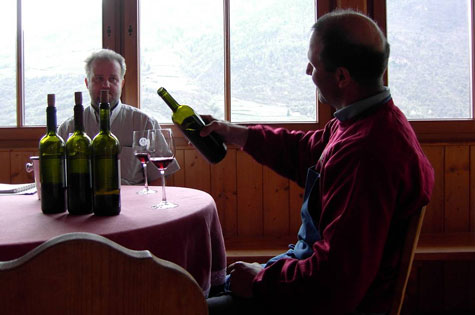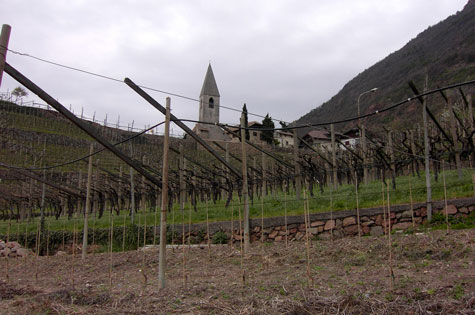| About Georg Ramoser |

|
He
may be firmly rooted in tradition, yet Georg Ramoser is one of the
most progressive wine makers in South Tyrol. Being a real professional,
his prime concern is to offer good value for money. Operating at
a rather small scale (4 acres of vineyards), he is enthusiastically
experimenting with varieties as Merlot and Chardonnay, already (or
almost?) traditional grapes in South Tyrol. Most recognition comes
his way for the Lagrein Riserva, a wine that gets high scores in
the Italian wine guides.
Despite the success of the Lagreins, he is perhaps even prouder
of his Sankt-Magdalener, for which interest is steadily growing
in Italy. Once an almost sweet and superficial table wine, this
has now become, thanks to (among others) Georg Ramoser, an intensily
fruity and solidly structured connoisseur wine.
Next to the vineyards surrounding the "Untermoserhof"
in Sankt-Magdalena, a tiny little village behind the hill from the
big city Bozen, Ramoser has a piece of land in Eppan-Berg, along
the "Südtiroler Weinstrasse". There he grows the
Chardonnay and Merlot in a very dense clay soil. |
|

|
|
| The wines of Georg Ramoser |
|
| Sankt-Magdalener Klassisch |
|
Vernatsch
(Schiava in Italian) is the most common of the native Tyrolean grapes
and the basis of many simple table wines. The St-Magdalener has
always been one of the best known Vernatsch products, and lately
the wine has been revigorated by quality driven producers such as
Georg Ramoser. The "Magdalener" is a light, fruity and
very dry red wine (97% Vernatsch, 3% Lagrein), albeit solidly structured
due to a 6 months stay in wooden barrels. "Klassisch"
means that the wine originates from a very limited region in the
surroundings of Bozen. Being a very versatile wine, it makes a fine
companion to meat as well as fish and, in the latter case, can be
served chilled. |
|
| Chardonnay |
|
Georg
Ramoser is not an amateur of "oaky" wines, so it does
not really come as a surprise that this very floral and fruity Chardonnay
has been ripened on oak for only 5%. A perfect example of a typical
Tyrolean Chardonnay: despite the concentrated fruit the wine remains
very "sec" and slim. (Exhausted, 02/11/2004.) |
|
| Lagrein |
|
The
Lagrein is an ancient native grape producing a dark and dense wine,
with an intense aroma of cocoa. The grapes for the Lagrein "Normal"
are growing in the flatter vineyards below the "Untermoserhof".
In Bozen, as in the rest of Europe, the summer of 2003 was extremely
hot, much to the benefit of the Lagrein grape, the heat being its
favorite weather condition. The wine has ripened on big wooden barrels
during 6 months. A nose of mocca and blueberries, even a hint of
black truffles. The taste is very rich and fruity, mocca reigns
but with abundant softness and roundness. With ageing the wine develops
a tertiary, say animal fragrance. Just like the Sankt-Magdalener
this is a unique product, difficult to compare with other wines. |
|
| Lagrein Riserva |
|
The
grapes used for the Lagrein Riserva come from the oldest vines growing
on the steep slopes around the "Untermoserhof". A "Riserva"
ripens for 2 years on oak barrels, resulting in a wine that bursts
with character and fruit. An almost impermeable purple color; a
nose of mocca and blackberries. Taste is concentrated, with fresh
and soft tannins, and a bitter-sweet finish, typical for the Lagrein.
"Due bicchieri" in the Gambero Rosso 2004. |
|
| Merlot Riserva |
|
Merlot
is at its best in a dense soil of sand or loam (or clay). The loam
soil of Eppan-Berg, where Ramoser grows his Merlot, is so thick
that you can hardly dig in it.
The Merlot is a very ripe and rich wine. A nose of tobacco and blackberries,
a beautifully structured flavour, soft tannins and a very long and
wonderful finish. Very drinkable, and "due bicchieri"
in the Gambero Rosso 2004.
According to the German wine writer Jens Priewe, Ramoser's Merlot
is to be counted among the best of Southtyrol. In his latest book
he mentions South Tyrol as one of the most interesting regions for
growing of Merlot. Ergo?
|
|
|